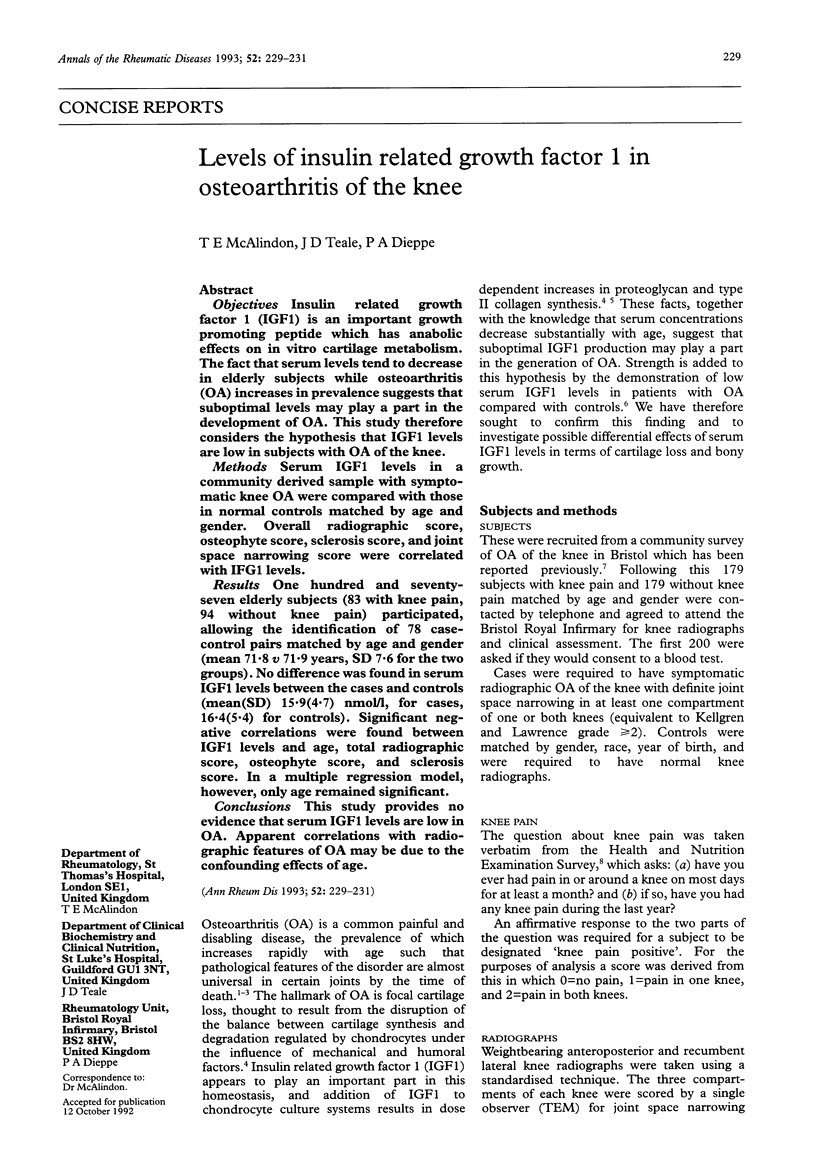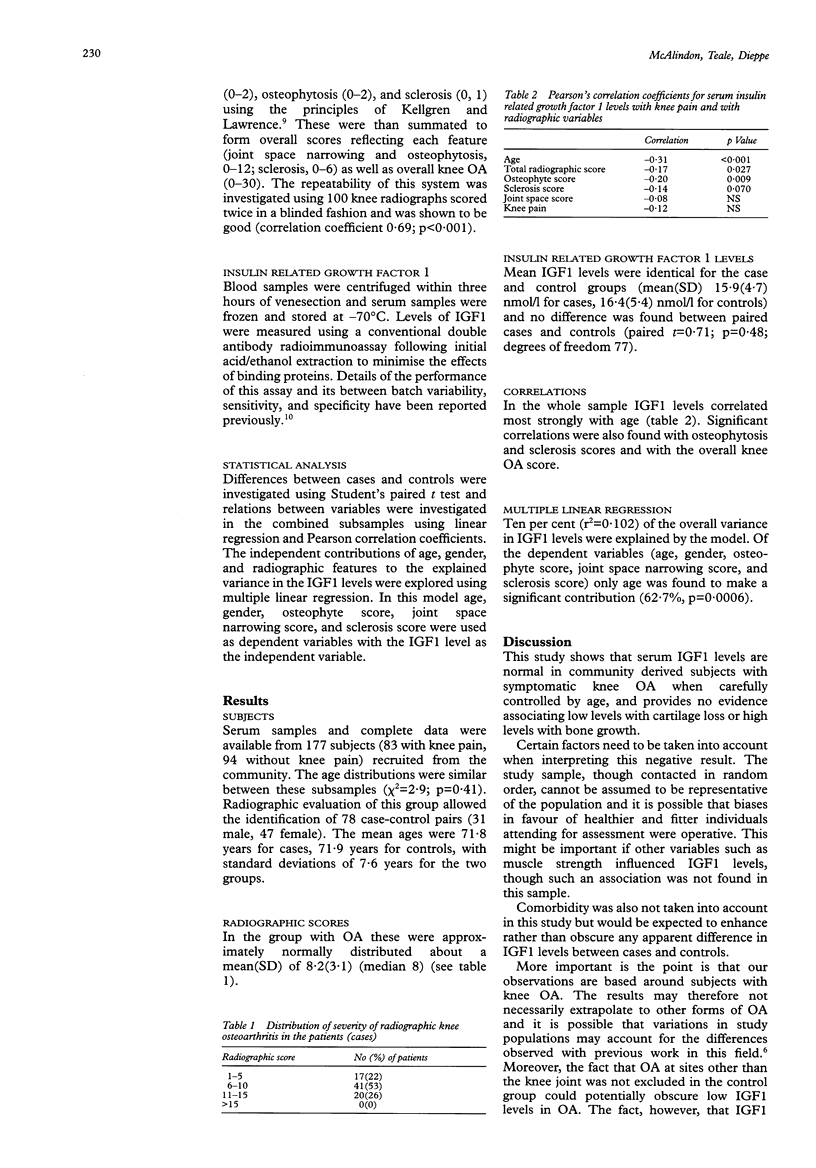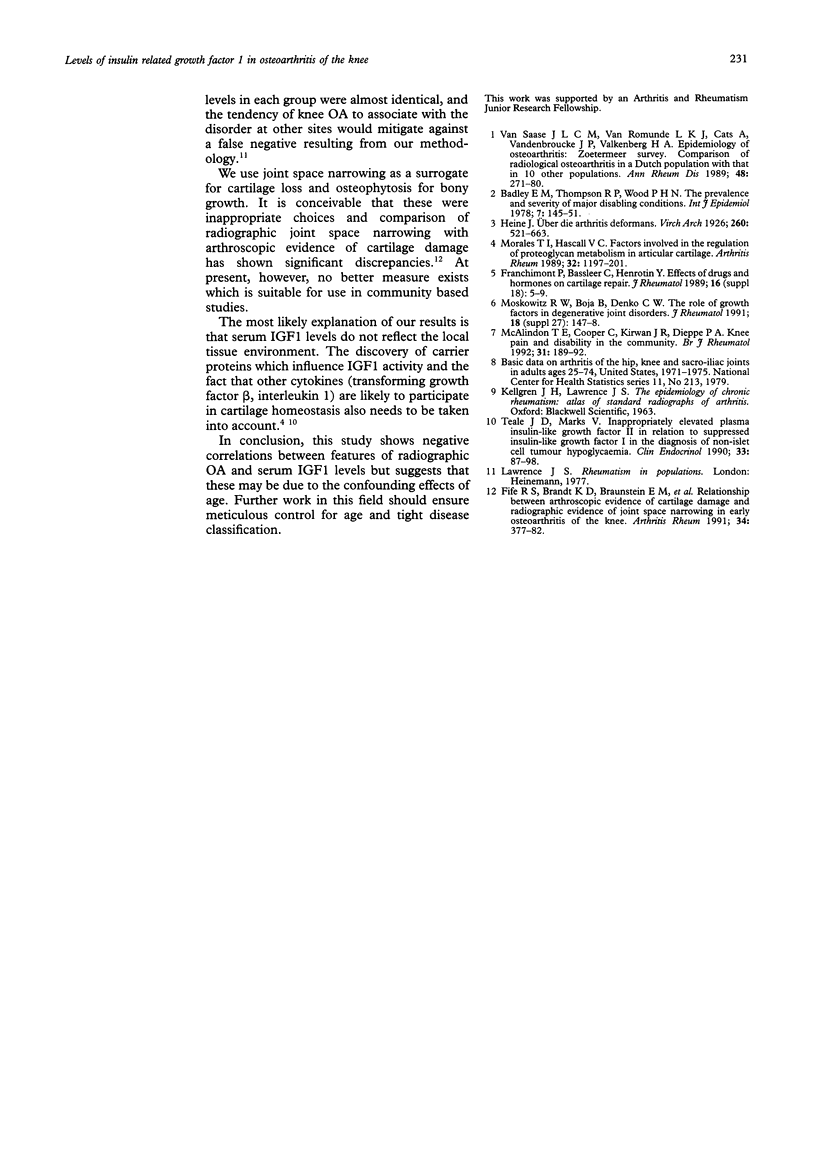Abstract
OBJECTIVES: Insulin related growth factor 1 (IGF1) is an important growth promoting peptide which has anabolic effects on in vitro cartilage metabolism. The fact that serum levels tend to decrease in elderly subjects while osteoarthritis (OA) increases in prevalence suggests that suboptimal levels may play a part in the development of OA. This study therefore considers the hypothesis that IGF1 levels are low in subjects with OA of the knee. METHODS: Serum IGF1 levels in a community derived sample with symptomatic knee OA were compared with those in normal controls matched by age and gender. Overall radiographic score, osteophyte score, sclerosis score, and joint space narrowing score were correlated with IFG1 levels. RESULTS: One hundred and seventy-seven elderly subjects (83 with knee pain, 94 without knee pain) participated, allowing the identification of 78 case-control pairs matched by age and gender (mean 71.8 v 71.9 years, SD 7.6 for the two groups). No difference was found in serum IGF1 levels between the cases and controls (mean(SD) 15.9(4.7) nmol/l, for cases, 16.4(5.4) for controls). Significant negative correlations were found between IGF1 levels and age, total radiographic score, osteophyte score, and sclerosis score. In a multiple regression model, however, only age remained significant. CONCLUSIONS: This study provides no evidence that serum IGF1 levels are low in OA. Apparent correlations with radiographic features of OA may be due to the confounding effects of age.
Full text
PDF


Selected References
These references are in PubMed. This may not be the complete list of references from this article.
- Badley E. M., Thompson R. P., Wood P. H. The prevalence and severity of major disabling conditions--a reappraisal of the government social survey on the handicapped and impaired in Great Britain. Int J Epidemiol. 1978 Jun;7(2):145–151. doi: 10.1093/ije/7.2.145. [DOI] [PubMed] [Google Scholar]
- Fife R. S., Brandt K. D., Braunstein E. M., Katz B. P., Shelbourne K. D., Kalasinski L. A., Ryan S. Relationship between arthroscopic evidence of cartilage damage and radiographic evidence of joint space narrowing in early osteoarthritis of the knee. Arthritis Rheum. 1991 Apr;34(4):377–382. doi: 10.1002/art.1780340402. [DOI] [PubMed] [Google Scholar]
- Franchimont P., Bassleer C., Henrotin Y. Effects of hormones and drugs on cartilage repair. J Rheumatol Suppl. 1989 Aug;18:5–9. [PubMed] [Google Scholar]
- McAlindon T. E., Cooper C., Kirwan J. R., Dieppe P. A. Knee pain and disability in the community. Br J Rheumatol. 1992 Mar;31(3):189–192. doi: 10.1093/rheumatology/31.3.189. [DOI] [PubMed] [Google Scholar]
- Morales T. I., Hascall V. C. Factors involved in the regulation of proteoglycan metabolism in articular cartilage. Arthritis Rheum. 1989 Oct;32(10):1197–1201. doi: 10.1002/anr.1780321003. [DOI] [PubMed] [Google Scholar]
- Teale J. D., Marks V. Inappropriately elevated plasma insulin-like growth factor II in relation to suppressed insulin-like growth factor I in the diagnosis of non-islet cell tumour hypoglycaemia. Clin Endocrinol (Oxf) 1990 Jul;33(1):87–98. doi: 10.1111/j.1365-2265.1990.tb00469.x. [DOI] [PubMed] [Google Scholar]
- van Saase J. L., van Romunde L. K., Cats A., Vandenbroucke J. P., Valkenburg H. A. Epidemiology of osteoarthritis: Zoetermeer survey. Comparison of radiological osteoarthritis in a Dutch population with that in 10 other populations. Ann Rheum Dis. 1989 Apr;48(4):271–280. doi: 10.1136/ard.48.4.271. [DOI] [PMC free article] [PubMed] [Google Scholar]


